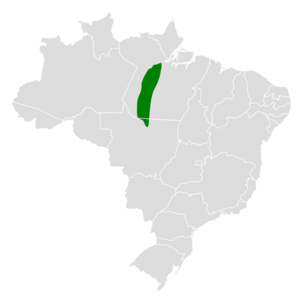Bare-eyed antbird facts for kids
Quick facts for kids Bare-eyed antbird |
|
|---|---|
 |
|
| Conservation status | |
| Scientific classification | |
| Genus: |
Rhegmatorhina
|
| Species: |
gymnops
|
 |
|
The bare-eyed antbird (Rhegmatorhina gymnops) is a special type of bird that eats insects. It's also sometimes called the Santarem antbird. This bird is considered a Vulnerable species, which means its numbers are getting low. It lives only in Brazil.
Contents
What is a Bare-eyed Antbird?
Appearance: What Does It Look Like?
The bare-eyed antbird is a small bird, about 13.5 to 14.5 centimeters (5 to 6 inches) long. It weighs around 27 to 30 grams (about 1 ounce). Both male and female antbirds have a cool crest of feathers on their heads. They also have a light grayish-green ring of skin around their eyes that has no feathers.
- Males: Adult males have a blackish-gray head and upper chest. Their backs and tails are a dark reddish-yellow-brown. Their wings are a brighter reddish-brown. Their bellies are dark grayish-brown.
- Females: Adult females have a brownish-black head and throat. Their backs, wings, and tails look similar to the male's. Their undersides are dark yellowish-brown.
- Young Birds: Young males look a bit like adult males but are browner. Young birds of both sexes have a reddish tint to their dark brown feathers.
All bare-eyed antbirds have dark brown eyes and dark gray legs and feet. Adult birds have a dark beak. Young birds have a dark upper beak and a pale lower beak.
Where Do Bare-eyed Antbirds Live?
The bare-eyed antbird lives in a small area in the southeastern part of the Amazon rainforest in Brazil. Its home is bordered by the Amazon River to the north, the Rio Tapajós to the west, and the Rio Xingu to the east. We don't know exactly how far south they go, but they live at least as far as the Teles Pires river in northern Mato Grosso state.
These birds mostly live in the lower parts of very wet, untouched primary rainforest. This type of forest is called terra firme. They have also been seen in várzea forests, which are flooded by rivers. They live in areas that are below 400 meters (about 1,300 feet) in elevation.
Antbird Behavior
How Do They Move?
Bare-eyed antbirds do not migrate. This means they stay in the same area all year round.
What Do They Eat?
The bare-eyed antbird is an "obligate ant follower." This means it always follows swarms of army ants, like Eciton burchelli and Labidus ants. These ants march through the forest, and as they move, they scare out all sorts of small creatures like spiders and insects. The antbirds then catch these creatures that are trying to escape!
Bare-eyed antbirds usually hunt alone, in pairs, or in family groups. They perch close to the ground, usually within 1 meter (about 3 feet) of it. From there, they quickly fly or pounce down to the ground to grab their prey. Sometimes, several family groups will gather around one ant swarm to feed. Bare-eyed antbirds are stronger than smaller antbirds when it comes to getting food, but bigger birds from other families, like woodcreepers, can push them away.
When Do They Have Babies?
Bare-eyed antbirds seem to have their babies during the rainy season, which is from November to February. We don't know much else about how they raise their young.
How Do They Communicate?
The bare-eyed antbird's song is made of 4 to 5 very high notes that go down in pitch. Each note is held out for a while. It sounds like "Heeeeee, hew-hew-hew-hew!"
Their calls include a harsh, strong "chirr", short "chip" sounds, and a thin "teeeeeee" whistle.
Why Are Bare-eyed Antbirds Vulnerable?
The IUCN (International Union for Conservation of Nature) first listed the bare-eyed antbird as "Near Threatened" in 1988. Then, in 2004, they thought it was "Least Concern." But since 2012, it has been listed as "Vulnerable."
This bird has a small home range, and we don't know exactly how many there are. However, their numbers are believed to be going down. The bare-eyed antbird is losing its home because of a lot of deforestation (forest clearing) in the Pará and Mato Grosso regions of Brazil. This deforestation has increased a lot since the 1960s. It's happening because of:
- Building roads
- Ranching (raising cattle)
- Small farms
- Mining
- Building hydroelectric dams (for electricity)
These birds are very sensitive to their forest home being broken up into smaller pieces. This is because they depend on army ants, which also need large, unbroken forests. Even though they sometimes cross rivers and narrow road gaps in continuous forest, they are still very much at risk from habitat loss.
See also
 In Spanish: Hormiguero ojicalvo para niños
In Spanish: Hormiguero ojicalvo para niños


